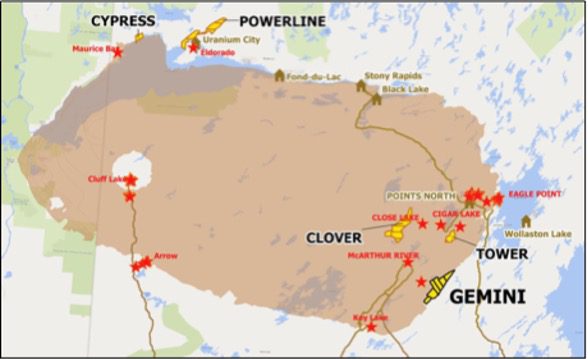Quickly Expands Land Holding At Saskatchewan Project
92 Energy Limited (ASX: 92E) has intersected a zone of elevated radioactivity in its inaugural drilling programme at the Gemini Project (the Project) in the Athabasca Basin, Saskatchewan, Canada.
Highlights:
• Drill hole GEM-004 intersected 5.3m of elevated radioactivity (>500 counts per second (cps)) as measured with an RS-125 hand-held spectrometer.
• The 5.3m interval of elevated radioactivity averages 760 cps and includes a 0.7m subinterval of stronger radioactivity (>1000 cps on an RS-125) that averages 1,500 cps.
• The intersection is approximately 190m below surface and is associated with a strong and broad zone of clay, hematite and quartz alteration, with common fault breccias and other structures.
• As GEM-004 is the first drill hole ever completed in this target area, the zone of elevated radioactivity is wide open, both on section and in plan view.
• Geochemical assay results for GEM-004 are expected within approximately four weeks to determine the extent of any uranium mineralisation.
• Seven new claims have been staked, adding approximately 122 sq. km of prospective ground contiguous with the original Gemini Project area.
• Gemini is located 27km southeast of the McArthur River uranium mine, one of the largest and highest-grade uranium deposits in the world
Drill Hole GEM-004 Drill hole GEM-004 targeted a VTEM conductor up-ice from radioactive bog samples, anomalous lake sediment samples and radioactive boulders. It was drilled along the southern edge of the Gemini Project at an angle of -55 degrees towards 305 degrees and penetrated 37m of overburden followed by Wollaston Group basement rocks through to the end of the drill hole at 327m.
A 5.3m interval of elevated radioactivity (>500 cps on an RS-125 hand-held spectrometer) was intersected from 229.9m to 235.2m. The 5.3m interval averages 760 cps and includes a 0.7m sub-interval of stronger radioactivity (>1,000 cps) from 234.3m to 235.0m that averages 1,500 cps.
The zone of elevated radioactivity is approximately 190m vertically below surface and 160m vertically below the top of the bedrock. All of the interval is hosted by basement rocks, at least 160m below the pre-erosional sub-Athabasca unconformity surface.
The elevated radioactivity is associated with a broad zone of moderate to strong clay, hematite and quartz alteration from 216m to 255m, all of which are commonly associated with uranium mineralization at unconformity-related uranium deposits in the Athabasca Basin.
The alteration zone is spatially related to strong structural disruption in the drill core that includes several intervals of fault breccia and gouge. As GEM-004 is the first drill hole ever completed in this target area, the zone of elevated radioactivity is wide open, both on section and in plan view.
The closest drill hole (GEM-003) is located 2.9km to the southwest. Table 1 summarizes the drilling completed to date.
Claim Staking
Following the results in drill hole GEM-004, a total of 122 sq. km of additional land has been staked by the company across seven claims. The new claims cover areas that are contiguous with the original Gemini Project area, are near the basin margin and are prospective for uranium mineralisation.
Next Steps
Due to the intersection in drill hole GEM-004, the summer drilling program has been paused to allow collection and interpretation of all drilling data, including geochemical analyses, to verify that the source of the elevated radioactivity is uranium and to determine its concentration in the core.
Geochemical assay results are expected within approximately four weeks. Additionally, the company will use this time to bolster radiometric safety protocols in anticipation of follow-up drilling designed to further test this zone of elevated radioactivity. As drill hole GEM-004 is only the fourth drill hole of a larger planned campaign, several other target areas remain to be evaluated.
For further information please visit: https://www.92energy.com/












